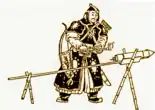863 Program
The 863 program (Chinese: 863计划) or State High-Tech Development Plan (Chinese: 国家高技术研究发展计划) was a program funded and administered by the government of the People's Republic of China intended to stimulate the development of advanced technologies in a wide range of fields for the purpose of rendering China independent of financial obligations for foreign technologies.[1] It was inspired by the Strategic Defense Initiative proposed by U.S. President Ronald Reagan in 1983, and was ended in 2016.[2][3][4]
| History of the People's Republic of China |
|---|
.svg.png.webp) |
| History of |
|
|
On March 3, 1986, the program was suggested by Wang Daheng, Wang Ganchang, Yang Jiachi, and Chen Fangyun in a letter to China's paramount leader Deng Xiaoping, who approved the program within 2 days.[5][6] The program was initially led by Zhao Ziyang, who was the Premier of China at the time, and received a governmental fund of 10 billion RMB in 1986, which accounts for 5% of the total government spending that year.[4][6][7]
Among the products known to have resulted from the 863 program are the Loongson computer processor family (originally named Godson), the Tianhe supercomputers and the Shenzhou spacecraft.[8][9][10]
History
| Part of a series on the |
| History of science and technology in China |
|---|
 |
Named after its date of establishment (March 1986, 86/3 by the Chinese date format), the 863 Program was proposed in a letter to the Chinese government by scientists Wang Daheng, Wang Ganchang, Yang Jiachi, and Chen Fangyun and endorsed by Deng Xiaoping.[11] After its implementation during the Seventh Five-Year Plan, the program continued to operate through the two five-year plans that followed, with state financing of around 11 billion RMB and an output of around 2000 patents (national and international).[12]
Under the plan, about US$200 billion was to be spent on information and communication technologies, of which US$150 billion was earmarked for telecommunications. In 1996 the key technological field of Marine Technology was added. The implementation took place during the Seventh Five-Year Plan and an update has been made during the period of the Tenth, which lasted from 2001 to 2005.
In 2001, under the Tenth Five-Year Plan, the program was reevaluated in consultation with foreign experts. The result was a widened focus to strengthen the competitiveness of China in the global economy.[13] The evaluation practice has been included into the program as a project management system.[14]
In a 2011 court case, Chinese-born scientist Huang Kexue was found guilty of stealing commercial secrets from US-based corporations and passing at least some of this information to the 863 program.[15]
Outline
The program initially focused on seven key technological fields:[16]
Since 1986, two more fields have been brought under the umbrella of the program:
- Telecommunications (1992)
- Marine technology (1996)
References
- Wu, Hequan (6 August 2002). "The progress of communication technology subject of hi-tech research development plan of China". WCC 2000 - ICCT 2000. 2000 International Conference on Communication Technology Proceedings (Cat. No.00EX420). Vol. 1. Beijing. pp. 3–4. doi:10.1109/ICCT.2000.889157. ISBN 0-7803-6394-9. S2CID 60832883.
{{cite book}}: CS1 maint: location missing publisher (link) - Zhi, Qiang; Pearson, Margaret M. (July 2017). "China's Hybrid Adaptive Bureaucracy: The Case of the 863 Program for Science and Technology" (PDF). Governance. 30 (3): 407–424. doi:10.1111/gove.12245. S2CID 152280888.
- "新华社:"973""863"取消后科研咋办?国家重点研发计划正式启动". Ministry of Science and Technology of China. Retrieved 29 November 2019.
- Gewirtz, Julian (February 2019). "The Futurists of Beijing: Alvin Toffler, Zhao Ziyang, and China's "New Technological Revolution," 1979–1991". The Journal of Asian Studies. 78 (1): 115–140. doi:10.1017/S0021911818002619. ISSN 0021-9118.
- "Ministry of Science and Technology of the People's Republic of China". www.most.gov.cn. Retrieved 29 November 2019.
- "1986年邓小平亲自决策启动"863"计划--邓小平纪念网--人民网". cpc.people.com.cn. Retrieved 29 November 2019.
- Karplus, Valerie J.; Deng, Xing Wang (17 December 2007). Agricultural Biotechnology in China: Origins and Prospects. Springer Science & Business Media. ISBN 978-0-387-71138-6.
- "Designing Quad-Core Loongson-3 Processor". english.ict.cas.cn. Retrieved 29 November 2019.
- "Scientific Innovation and China's Military Modernization". thediplomat.com. Retrieved 29 November 2019.
- "Shenzhou". China Space Report. 10 September 2016. Retrieved 29 November 2019.
- Feigenbaum, Evan A. (2003). China's Techno-warriors: National Security and Strategic Competition from the Nuclear to the Information Age. Stanford, California: Stanford University Press. p. 141. ISBN 978-0-8047-4601-4. OCLC 49415750.
- Science & Technology Newsletter No.380: 863 Program Creates RMB 56 Billion, Ministry of Science & Technology of the People's Republic of China (MOST), archived from the original on 20 November 2014
- "National High-tech R&D Program (863 Program)". Ministry of Science and Technology of the People's Republic of China. Retrieved 1 April 2015.: 1. Orientation and Objectives, 2. Major Tasks.
- "National High-tech R&D Program (863 Program)". Ministry of Science and Technology of the People's Republic of China. Retrieved 1 April 2015.: 4. Organization and Management, 2) Project Management.
- BBC News Chinese scientist Huang Kexue jailed for trade theft December, 22nd 2011
- Ke Yan (Ke, Yan), Science and Technology in China, German Edition (Beijing 2005), p.109 Passages readable online